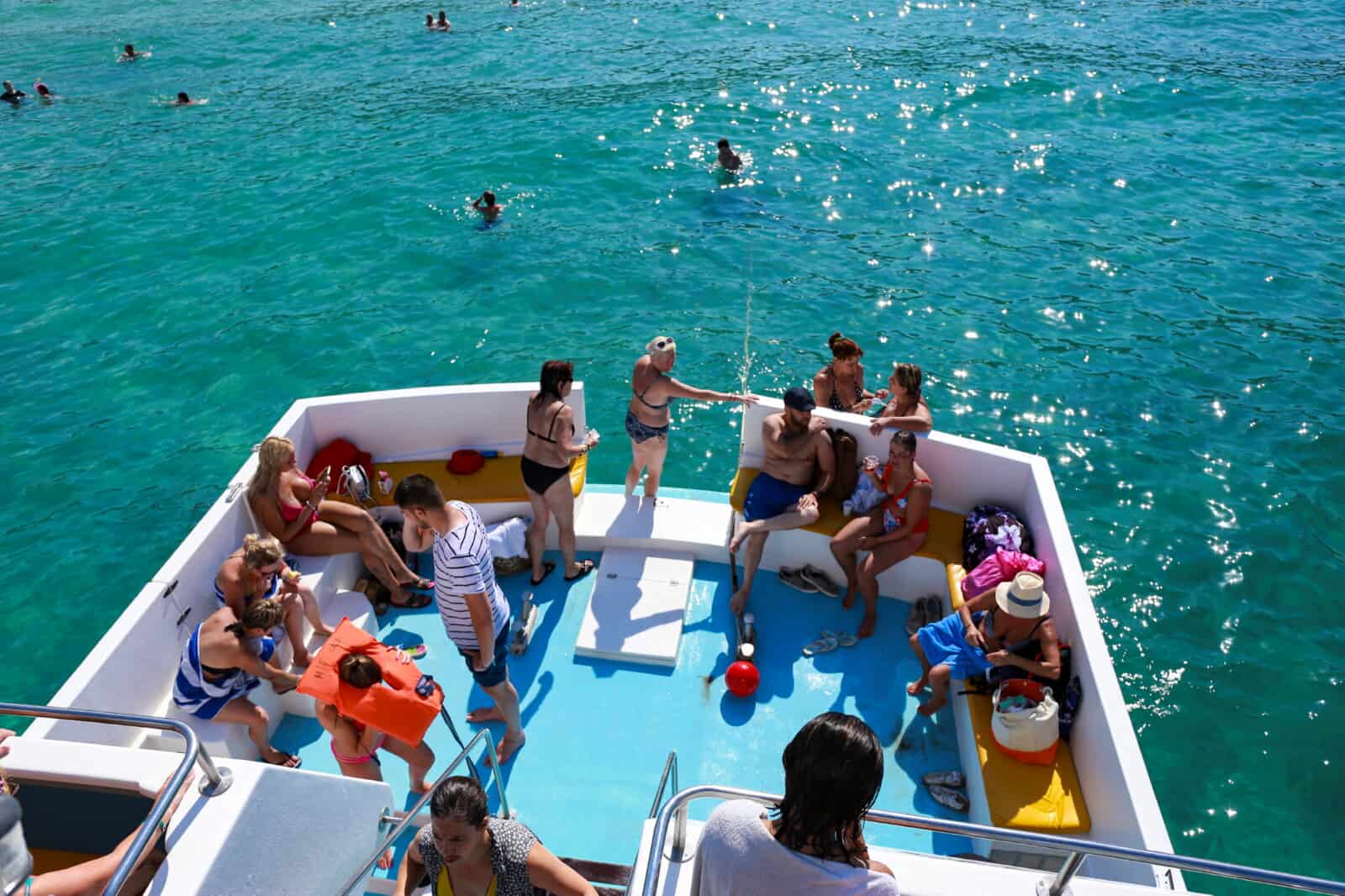
The wood ovens are in their glory in the middle of summer… We could easily say that ofton kleftiko is, after the spit, the national food of the Cypriots. For many, stealing is synonymous with summer. The hot Cypriot summer evenings require loose clothing, an airy courtyard without much fuss, chakra beer and a well-cooked, fragrant kleftiko accompanied by its potatoes, oatmeal and fresh, fresh salad!
One could say that goat and lamb meat is heavy for the summer, and especially for eating at night. But it is a tradition that does not change with anything, because it continues to offer pleasure, not only in taste, but in all the senses. Ofton kleftiko is not only about the taste of food. It is the whole experience that counts and I like. For some, the experience is the conversation with the figure of the simple tavern owner, for others the meeting with the company in a completely relaxed place that lifts the mood, for others it is the stories that will unfold in an unpretentious environment, a combination which will make us let go and relax.
It is true that many Cypriots, especially men with their familiar well-nourished bellies, consider themselves thieves of the thief, but in reality those who “understand” are much fewer. This is a common view of the three fanatical tavern owners, known for their theft in the province of Nicosia, whom we visited. From Kyriakos to Pallouriotissa, Dionysis to Akaki and Theodosius on Monday we tried to unravel the secrets of the well-cooked thief…
Theodosius' trout on Monday
Theodosius' tavern is housed in a traditional Cypriot house on Monday which belonged to his great-grandfather and was an inn. When his grandfather Theodosius inherited it, he turned it into a butcher shop, while in the summers he set tables in the yard and made kleftiko. Many visitors of the festival of Chrysospiliotissa on the 15th of August ate stealthily from their grandfather's hands. “I learned the art from my father and he from his own father”, Theodosis tells us as he serves us the slippery steal that he just took out of the oven. It is called Syrto because it enters the wood oven in bulk. Without being wrapped and without being put in a pan. The usual tactic of those who make krto kleftiko is to tie it with twine or thread or put it in a diaper – the thin plastic film that we wrap the seftalies – so that they can then serve the portion. Besides, when the meat is cooked well, it tends to come off the bone and so with the binding, the portion remains unchanged.

Half of those who eat kleftiko understand what they are eating, Theodosis tells us. “I heard a lot of different things. They ask if the meat is beef or if it also has chicken ofton! In the photo, his wonderful yard on Monday.
Why only in summer?
We ask Theodosius why only in the summer is the kleftiko served mostly. “I open the oven around eight in the evening, but the food is kept hot for another two hours δηλαδή As long as we serve the customers. In winter, when the temperature is much lower, as soon as we open the oven the kleftiko will cool down and thicken (s.s. goat fat). “Summer temperatures, then, help us keep it warm.”
Cypriot meat
“Stealing is a whole science” and this is the prevailing view of those who make it. “It takes about eight hours for the meat to cook well,” Theodosius explains. This is because in order for the theft to take place properly, the animals must be older. The common secret, he tells us. is meat to be good. That is, to be Cypriot and not frozen, to have its fat to help it cook and get its delicious taste. He only bakes a goat.
In Theodosi's shop one can also eat rice baked in the same wood oven where the potatoes are baked for 6-7 hours. The rice is made with a secret sauce that Theodosius bequeathed to his grandfather. The portion of ofto with potatoes, rice, cups and appetizers costs 12 euros per person.

Theodosius “fires” the oven for four hours every morning. “He wants it to burn slowly to digest the stew, because then if you pomp it and put the meat in it, it will hit you,” he explains.
The clay urns of Kyriakos
Kyriakos kleftiko in Pallouriotissa is one of the most famous in Nicosia. A refugee from Dikomo, Kyriakos has been making kleftiko for almost 40 years. “It's a difficult job. It has its requirements. It takes about six hours for the kleftiko to be cooked. We start with the preparations from 8 in the morning. Our kleftiko is made in clay pots that go into the oven. We salt the sliced meat, we put it in the bag, we close it with greaseproof paper and when the oven heats up we put it inside “.
This style of tsoukali makes the meat juicier. This is the main difference with the trout, Mr. Kyriakos explains. “The upper portions of the clay pot are drier. As you go down, the pieces become more and more juicy. Some prefer the dry, others the juicy. Whatever the customer wants “.


In a clay pot the thief of Kyriakos. With this technique it becomes juicier than the syrto.
Milk and grass
And Mr. Kyriakos' secret is the right choice of meat. “We take care of the portion. “We remove the excess fat and the excess bone and make a balanced portion”, he tells us, adding that baking requires mastery. “You learn these through experience. That is, how much do you have to heat the oven in order not to burn it or leave it raw “.
He considers it a myth that you can no longer make kleftiko in the winter. This was obviously the case in earlier times. Because today it is not difficult to keep a plate of fai hot until it is eaten.
“The most important reason why the old people did not steal in the winter was that they took out the animals and ate green grass in the winter. And the grass changes the taste of the meat. Of course, you can avoid that today. You can feed your animals dried hay… The other is that in winter the animals give birth and the shepherds do not slaughter them because they get their milk. “I think that is the main reason why large animals are not slaughtered in winter and take out the 'scrap' for slaughter in summer.”
On Sunday one can eat both goat and sheep, whatever one prefers, because the tsoukali has both. The portion of the kleftiko with the potatoes costs 8.60 euros per plate. Do not forget to order the porridge.

The tavern of Kyriakos operates only in summer in a beautiful courtyard with lemon trees in the center of Nicosia. “We always start near Easter and go until the end of October. You can also steal in the winter, but people do not like it. “They consider it summer food,” he tells us.
In the yard of Dionysis in Akaki
We arrived at the yard of Dionysis, at the Hunting Association of Akaki, relatively early. Around seven in the afternoon. The oven had not yet opened and Mr. Dionysis would come in a little fresh after his afternoon rest to cope with the evening orders.
In the interval until the arrival of Mr. Dionysis, Jason and Lakis arrived – early admittedly – from Nicosia. They guarded their appetite. They are accustomed to eating kleftiko once every ten days. “We are waiting for it and how do we expect the theft every summer.” Each time they eat and a special experience, usually in a different hangout. “Not everyone succeeds. All the magic is to open the oven and be baked and soft. Do not be raw, do not hit. We usually choose the hangout based on the suggestions of the 'tall'. The 'tall' has eaten all over Cyprus. His reason is a guarantee. He told us to come here. ”
With lemon wood
Mr. Dionysis arrives shortly. As he explains to us, he chooses not to put too much hard meat, and in fact only lamb. His style is trolling.
“95% of those who make kleftiko in Cyprus put it in the sini. But this is no different from how we make roast at home. It is softer, but it is full of cholesterol, because it is cooked in fat “.
As he explains to us, he prefers the lamb, because the goat “makes us in the cage. If it is a kid and it is dry, do not put it in the oven. It will become tsamarella. The meat must also have miles on it to be trotted. That's how the old people made it. “
The firing of the oven for six hours in Dionysis is done with lemon wood only. Wood is important, he says, because it will give the meat its smell. “They say about the wood of the huge jai pellares. More fragrant wood that the lemon does not have. I start firing the oven around six in the morning and at 12 I start to take out the coals and mop the oven to keep it clean when I drag the meat inside. Of course, I always put a little silver paper around and on it so that it does not burn me. “Because the meat that comes in hits the walls.” The oven closes with a gate to open 7-8 hours later.
“The kleftiko takes 4 hours to cook. But in order to become a thief properly, he wants his hours. Like a good food to make and taste “.
Dionysis serves kleftiko with potatoes, porridge, meatballs and lamb liver. Along with a fresh salad with wild portulaca, cucumber and tomato that were cut the same day. “She is alive. We have an orchard and we cut them “. The price, 10 euros per person.

The secret of Mr. Dionysis from Akaki? “Gums came out with what I do to him in such a nice way. “Kleftiko is a great science”, he tells us, taking a piece of lamb kleftiko out of the oven.

The quiet and cool courtyard of the tavern of Dionysis next to the orchard, away from the noise of the city. In the background the friends from Nicosia who trusted the “tall” and made so much way to eat stealthily in Akaki.




